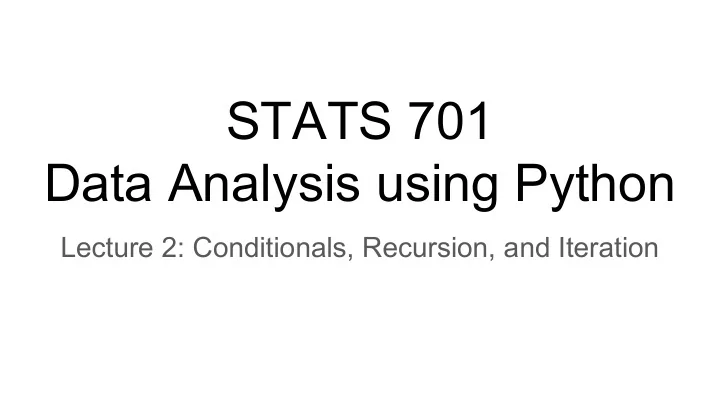

STATS 701 Data Analysis using Python Lecture 2: Conditionals, Recursion, and Iteration
Boolean Expressions Boolean expressions evaluate the truth/falsity of a statement Python supplies a special Boolean type, bool variable of type bool can be either True or False
Boolean Expressions Comparison operators available in Python: Expressions involving comparison operators evaluate to a Boolean. Note: In true Pythonic style, one can compare many types, not just numbers. Most obviously, strings can be compared, with ordering given alphabetically.
Boolean Expressions Can combine Boolean expressions into larger expressions via logical operators In Python: and , or and not Note: technically, any nonzero number or any nonempty string will evaluate to True , but you should avoid comparing anything that isn’t Boolean.
Boolean Expressions: Example Let’s see Boolean expressions in action Reminder: x % y returns the remainder when x is divided by y . Note: in practice, we would want to include some extra code to check that n is actually a number, and to “fail gracefully” if it isn’t, e.g., by throwing an error with a useful error message. More about this in future lectures.
Conditional Expressions Sometimes we want to do different things depending on certain conditions
Conditional Expressions Sometimes we want to do different things depending on certain conditions This is an if-statement .
Conditional Expressions Sometimes we want to do different things depending on certain conditions This Boolean expression is called the test condition , or just the condition .
Conditional Expressions Sometimes we want to do different things depending on certain conditions If the condition evaluates to True , then Python runs the code in the body of the if-statement.
Conditional Expressions Sometimes we want to do different things depending on certain conditions If the condition evaluates to False , then Python skips the body and continues running code starting at the end of the if-statement.
Conditional Expressions Sometimes we want to do different things depending on certain conditions Note: the body of a conditional statement can have any number of lines in it, but it must have at least one line. To do nothing, use the pass keyword.
Conditional Expressions More complicated logic can be handled with chained conditionals
Conditional Expressions More complicated logic can be handled with chained conditionals This is treated as a single if-statement.
Conditional Expressions More complicated logic can be handled with chained conditionals If this expression evaluates to True ...
Conditional Expressions More complicated logic can be handled with chained conditionals ...then this block of code is executed...
Conditional Expressions More complicated logic can be handled with chained conditionals ...and then Python exits the if-statement
Conditional Expressions More complicated logic can be handled with chained conditionals If this expression evaluates to False ...
Conditional Expressions More complicated logic can be handled with chained conditionals Note: elif is short for else if . ...then we go to the condition. If this condition fails, we go to the next condition, etc.
Conditional Expressions More complicated logic can be handled with chained conditionals If all the other tests fail, we execute the block in the else part of the statement.
Conditional Expressions Conditionals can also be nested This if-statement...
Conditional Expressions Conditionals can also be nested This if-statement... ...contains another if-statement.
Conditional Expressions Often, a nested conditional can be simplified When this is possible, I recommend it for the sake of your sanity, because debugging complicated nested conditionals is tricky! These two if-statements are equivalent, in that they do the same thing! But the second one is (arguably) preferable, because it is simpler.
Recursion A function is a allowed to call itself, in what is termed recursion Countdown calls itself! But the key is that each time it calls itself, it is passing an argument with its value decreased by 1, so eventually, n <= 0 is true.
With a small change, we can make it so that countdown(1) encounters an infinite recursion , in which it repeatedly calls itself.
Repeated actions: Iteration Recursion is the first tool we’ve seen for performing repeated operations But there are better tools for the job: while and for loops.
Repeated actions: Iteration Recursion is the first tool we’ve seen for performing repeated operations But there are better tools for the job: while and for loops. This block specifies a while-loop. So long as the condition is true, Python will run the code in the body of the loop, checking the condition again at the end of each time through.
Repeated actions: Iteration Recursion is the first tool we’ve seen for performing repeated operations But there are better tools for the job: while and for loops. Warning: Once again, there is a danger of creating an infinite loop . If, for example, n never gets updated, then when we call countdown(10) , the condition n>0 will always evaluate to True , and we will never exit the while-loop.
Repeated actions: Iteration One always wants to try and ensure that a while loop will (eventually) terminate, but It’s not always so easy to know! https://en.wikipedia.org/wiki/Collatz_conjecture “Mathematics may not be ready for such problems." Paul Erdős
Repeated actions: Iteration We can also terminate a while-loop using the break keyword The break keyword terminates the current loop when it is called. Newton-Raphson method: https://en.wikipedia.org/wiki/Newton's_method
Repeated actions: Iteration We can also terminate a while-loop using the break keyword Notice that we’re not testing for equality here. That’s because testing for equality between pairs of floats is dangerous. When I write x=1/3 , for example, the value of x is actually only an approximation to the number 1/3. Newton-Raphson method: https://en.wikipedia.org/wiki/Newton's_method
Readings (this lecture) Required: Either Downey, Chapters 5, 6 and 7 or Severance Chapters 4 and 5 Recommended: Python documentation on conditionals: https://docs.python.org/3/reference/compound_stmts.html
Readings (next lecture) Required: Downey Chapters 8 and 10 or Severance Chapters 6 and 8 Recommended: Downey Chapter 9 Python documentation on lists: https://docs.python.org/3/library/stdtypes.html#lists Python documentation on sequences: https://docs.python.org/3/library/stdtypes.html#typesseq
Recommend
More recommend